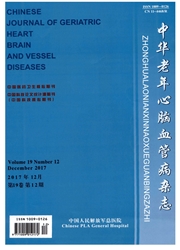

 中文摘要:
中文摘要:
目的评价程序化撤机策略在重症脑梗死患者机械通气(MV)中的应用价值。方法分别采用程序化撤机(程序组,34例)和经验性撤机(经验组,35例)2种方法对MV的重症脑梗死患者进行撤机试验,对比2组撤机成功率、MV时间、住院时间以及呼吸机相关性肺炎(VAP)等并发症的发生率和住院费用。结果程序组撤机成功率高于经验组(67.6%'US42.9%,P〈0.05);与经验组比较,程序组撤机前MV时间、总MV时间和住ICU时间均明显缩短,差异有统计学意义(P〈0.05)。程序组VAP发生率、气管切开、住院死亡和住院费用方面均明显低于经验组(P〈0.05);2组48h内再插管比较差异无统计学意义(P〉0.05)。结论程序化撤机策略能提高撤机成功率,缩短MV时间,降低并发症发生率,减少住院费用,为脑梗死患者提供了一种安全且有效的撤机方式。
 英文摘要:
英文摘要:
Objective To assess the value of protocol weaning from mechanical ventilation (MV) in patients with severe cerebral infarction. Methods Sixty-nine patients with severe cerebral infarction were divided into protocol weaning group (n=34) and empirical weaning group (n =35). Their weaning success rate, MV time, hospital stay time, complications of ventilator-associated pneumonia (VAP) and hospital costs were compared between the two groups. Results The weaning success rate was significantly higher in protocol weaning group than in empirical weaning group (67.6% vs 42.9% ,P〈0.05). The MV time,total MV time and ICU stay time were significantly shorter in protocol weaning group than in empirical weaning group before weaning (P〈 0.05). The incidence of VAP, tracheotomy rate, hospital mortality, and hospital cost were significantly lower in protocol weaning group than in empirical weaning group (P〈0.05). No significant difference was observed in 48 h re-intubation between the two groups (P〉0.05). Conclusion Protocol weaning from mechanical ventilation can improve the success rate,shorten the MV time, reduce the incidence of complications and hospital cost and is thus a safe and effective weaning procedure in patients with cerebral infarction.
 同期刊论文项目
同期刊论文项目
 同项目期刊论文
同项目期刊论文
 期刊信息
期刊信息
